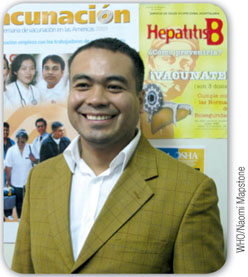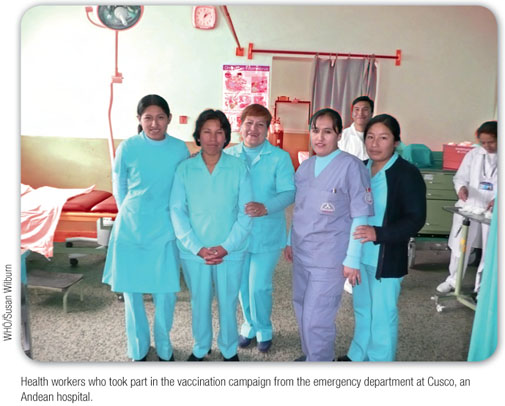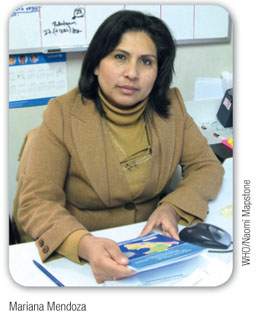NEWS
Mass vaccination of health workers in Peru
When Peru's government committed to immunizing the country's 350 000 health-care workers against hepatitis B, many policy-makers expected the greatest challenge to be logistics. Naomi Mapstone reports.
This Andean nation of 29 million people has one of the most diverse geographies in the world, with 25 regional health departments overseeing services for the sprawling capital of Lima, as well as remote villages in the high mountain ranges of La Sierra and pockets of the Amazon rainforest accessible only by boat.
Poor infrastructure and social protest, involving tactics such as cutting road and rail access, can present further obstacles to planners, especially when trying to reach isolated indigenous communities.
"Peru has intermediate endemicity of hepatitis B, with areas of both high and low endemicity that have left the country with high rates of liver cirrhosis and liver cancer," says Dr Manuel Peña, the Pan American Health Organization (PAHO) representative in Peru. "The annual mortality rate from liver cirrhosis is 10.45 per 100 000 population and mortality rate from liver cancer is 0.98 per 100 000 population. In endemic areas, about 7% of deaths from liver disease are related to hepatitis B infection, including liver cancer, cirrhosis and fulminant hepatitis."
While the need for action was clear, rolling out such a large-scale project meant liaising between the state, private enterprise and civil society groups, says Peña. "To ensure the availability of vaccines in all health facilities in the country we used the logistic systems of the Ministry of Health as well as the Ministry of Social Security, the armed forces and some health institutions in the private sector," he says.
The campaign kicked off in 2008, making Peru the first country in the world to start working towards the goal of full hepatitis B vaccine coverage for health-care workers under the Global Plan of Action on Workers' Health, which was set at the 2007 World Health Assembly. The World Health Organization (WHO) estimates that occupational exposure to hepatitis B mainly from needlestick injuries accounts for some 37% of the disease burden among health-care workers worldwide and that 95% of this fraction of the burden can be prevented with immunization.
In the United States of America, after mandatory hepatitis B vaccination was introduced for health-care workers in 1992, annual cases dropped significantly from 17 000 in 1983 to 400 in 1995, according to research published in the Archives of Internal Medicine in 1997.
Peru's health-care worker campaign began as part of a broader effort to vaccinate some 11.5 million people, the majority between the ages of 2 and 19 years. The country has been a leader in hepatitis B vaccination for the past 20 years and was one of the first to initiate hepatitis B vaccination at birth.
Mariana Mendoza, director of the Ministry of Health's national immunization programme, says opposition by some health-care workers added to the logistical challenge. "For us, health-care workers are a small group of people to immunize [relative to the wider population]," she says. "In each region we have personnel who can implement this, so reaching them was not the problem some workers were opposed to vaccination, however."
Initially, support for the hepatitis B immunization programme was high, with 95.5% of workers receiving the first dose in April 2008. But only 75% returned for a second dose. Only 53.5% of workers took the third and final dose in October the same year.

Dr Yoan Mayta, head of the occupational health and safety programme for health-care workers within the Ministry of Health, was the man charged with turning around public opinion. "It's a paradox. If you can't convince a health-care worker to take the hepatitis B vaccine, whom can you convince?" Mayta concedes laughingly, when asked if he had been surprised by the level of resistance to the campaign.
The opposition was spearheaded by doctors who argued that the vaccine that was being offered free to workers was substandard, containing high levels of thimerosal, a preservative that contains ethyl mercury. Dr Herbert Cuba, of the Peruvian Medical Association, was perhaps the campaign's most outspoken critic, arguing that studies by the National University of San Marcos in Lima had shown early-stage neurological disorders in rodents that had been inoculated.
But Dr Patrick Zuber, from WHO's Department of Immunization, Vaccines and Biologicals, dismisses these claims as unfounded, stating that "the safety record of the hepatitis B vaccine is excellent. No serious study has ever documented a significant health risk." Since 2000, the Global Advisory Committee on Vaccine Safety established by WHO has been assessing research worldwide on mercury in vaccines and concludes that there is no evidence of toxicity in infants, children or adults exposed to thimerosal in vaccines.
According to Peña, Cuba and his followers "systematically ignored all the pronouncements of scientific associations, such as the Medical School of Peru and the Peruvian Society of Pediatrics, who have provided vast scientific evidence to prove that thimerosal used in vaccines is not a health hazard."
In spite of the scientific evidence to the contrary, Cuba's message resonated with some health-care workers, such as Candy Ramirez Heredia, who has worked as a nurse for 10 years in private clinics in Lima. She strongly supports hepatitis B vaccination but says that she and many of her peers believe the developing world receives vaccines of lesser quality. "They always buy the cheapest vaccines," she says. "We see a much higher rate of reactions, with redness around the injection site and pain. We see that all the time."
However, according to Alba Maria Ropero Alvarez, regional adviser, Immunization Project, Department of Family and Community Health at PAHO, no adverse effects were reported from the campaign. She says that the vaccine was purchased through PAHO's revolving fund and was prequalified by WHO.

"It is inconceivable that there are still health professionals who are not adequately informed on the safety of these vaccines and the procedures that the Ministry of Health uses to deliver vaccines of very high quality and very low cost," adds Peña.
Faced with such negative claims, Mayta worked closely with the former minister of health, Hernán Garrido Lecca, using radio and television interviews, public meetings, office posters and palm cards to inform and reassure workers. "The dialogues with the minister were very important in turning around opinion. I am definitely pleased with our progress," says Mayta. Other public figures, such as Mercedes Araoz, then minister of trade, also had their vaccinations in public in a bid to shore up confidence.

The campaign made it very easy for workers by providing the vaccine at their workplace. It also provided an opportunity to strengthen occupational health services for workers and improve procedures for managing the risks of exposure to bloodborne pathogens.
As Peru prepares to begin a "catch-up" round of vaccinations, Mayta says the number of workers opposed to immunization has dropped from 46.5% to around 10%. A short film developed by WHO and dubbed into Spanish has been especially effective in persuading doubters to take the vaccine, he says. "The film features two nurses, one a triage nurse with 20 years in the job, who both contract hepatitis B and HIV after accidents at work. It's something that can happen to our workers and the message is powerful," he adds.
Back at the private Lima clinic, where Ramirez works, the nurse says that despite her misgivings she thinks most workers will eventually decide that the risks are too great to refuse vaccination: "We all know that hepatitis B is highly contagious, it's just too risky to work without protection. And even if people would prefer a French-made vaccine, you don't look a gift horse in the mouth." 
